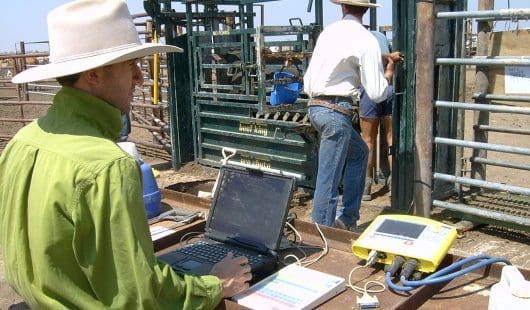
Data collection on the Barkly Tableland … the CashCow project demonstrated the potential of electronic monitoring, Mike McGowan says.
New University of Queensland research is aiming to build on the findings from the important MLA-funded CashCow project by looking at reducing foetal and calf losses in beef cattle breeding herds across northern Australia.
UQ school of veterinary science Professor Mike McGowan said the university had collaborated on research with MLA over many years, and the new $273,000 study would progress findings from the $2.47 million CashCow project.
“The new project will focus on identifying current and potential new management practices used in northern Australia that target key intervention points where we can reduce losses between confirmed pregnancy and weaning,” Prof McGowan said.
In what was a research project of epic proportions, the CashCow project investigated the fertility of more than 78,000 cows in 142 breeding mobs from 72 commercial enterprises across northern Australia over four years. The work was carried out by researchers from the UQ School of Vet Science, the Queensland and NT governments, Outcross Performance, Ausvet, and cattle veterinarians and commercial cattle producers across northern Australia.

Mike McGowan
“The project demonstrated that high-quality research can be conducted on commercial beef cattle properties,” Prof McGowan said.
The main thrust was to identify major factors affecting the likelihood of cows becoming pregnant, and why some pregnant cows successfully weaned their calves while others failed to do so.
To better understand the link between northern herd productivity and reproduction, researchers developed new measures of annual liveweight production from breeding herds such as ‘kilograms weaned per cow’ and determined production rates by broad geographic region.
Additionally tools were developed for monitoring breeding herd productivity and business performance.
“CashCow also demonstrated the real potential of electronic monitoring of herd performance and how data derived from this can be used by producers to understand and improve performance of their herds,” Prof McGowan said.
He said there were an estimated 15.4 million cattle in Northern Australia, earning about $3.7 billion for producers per annum. Fifty percent of the output from these cattle is exported annually.
MLA research and development manager for grassfed beef, Dr Nigel Tomkins, said MLA’s intention in supporting the new research was to make a sizeable contribution to the Meat Industry Strategic Plan 2020 imperatives.
“We are seeking continuous improvement of animal welfare and increased livestock productivity,” Dr Tomkins said.
- University of Queensland’s School of Veterinary Science is celebrating its 80th anniversary this year.
Source: UQ Vet School
